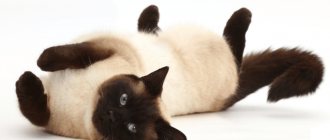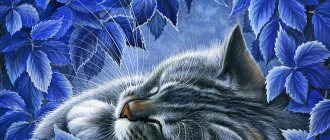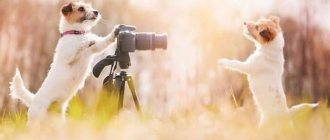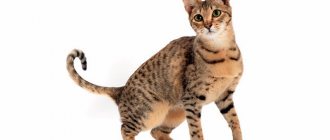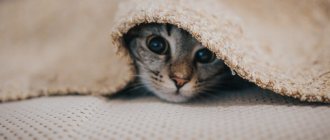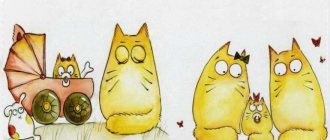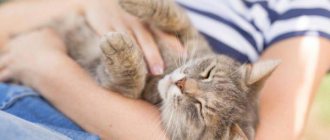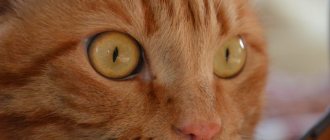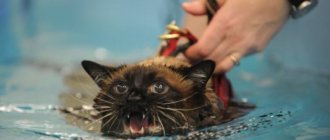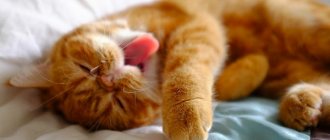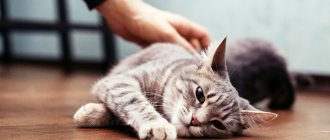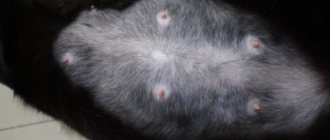How can you tell if a kitten is purebred or not?
Felinology is a science that studies the characteristics and behavior of domestic cats. This industry employs professionals who can determine the breed of a kitten. All the main features are recorded in the registration books. If your furry friend meets certain standards, he is classified as one or another breed.
A purebred cat is awarded a special document that contains his entire pedigree, the characteristics of the purr breed, and even the names of two or three of his ancestors. Yes, yes, everything is so serious.
Mr. Cat recommends: Online locator
Today, in the age of the ubiquitous Internet, to determine or clarify the breed of a pet, you can turn to “online identifiers”.
These virtual assistants are tables that systematize the breed characteristics of a wide variety of cat representatives. Simply by answering the questions posed using logical chains, you can determine whether the animal is purebred and which group it belongs to.
In this case, it is advisable to evaluate an adult animal; it is impossible to test a newborn here. The kitten needs to mature for at least six months in order for its breed characteristics to appear.
Methods for determining cat breed
There are several ways to determine the breed of a cat. For the most part, they are designed for the external characteristics of the pet. Just take a closer look at these signs of a particular breed:
Often, a pet's unusual ears help determine the cat's breed. Most yard furry dogs have ears that point upward and have a pointed shape. But as for purebreds, here you can find more original ears, which differ in shape, direction, and location to each other.
For example, forward-curved ears are the main characteristic of the Scottish Fold or Highland Fold cat. While facing backwards means that you are looking at an American Curl. By the way, this is the only breed whose ears are folded back.
Some other breeds can also be distinguished:
- Ukrainian Levkoy. You definitely won't pass by such a purr. His ears are curled into a tube and are almost invisible.
- Poodlecat. Features large floppy ears.
In the face
Now let's figure out how to find out what breed a cat is by its face. This factor is not decisive. It just helps reinforce your assumptions based on the cat's other characteristics. Just note that:
- An elongated muzzle and a wedge-shaped head are a feature of Siamese or Angora cats.
- A round muzzle and a flattened nose indicate that this is an exotic breed (Persian or exotic).
Body type
How to find out your cat's breed by body type? Everything is quite simple here. Of course, many individuals of different breeds have similar physiques. Therefore, building your guesses solely on this factor is not the best idea. However, there is no denying that the body structure can tell not only about the health status of your cat, but also about what breed it belongs to:
- A dense body structure with a large round head and short legs is a characteristic of breeds such as the Scottish Fold, American Shorthair or Bobtail.
- Muscular pets most often belong to the American Curl or Maine Coon breed. They also have medium length legs and a round head.
- Flexible cats with thin legs are found in breeds such as Siamese, Thai, Angora, and Balinese.
Coat type
Now let's talk about how to determine the breed of a cat at home by its hair type. Among the furry pets there are long-haired cats, purrs with curly hair, short-haired and hairless cats.
Very long, beautiful and fluffy fur can be:
- Himalayan cats. A combination of Persian and Siamese cats. From the first they took the physique and long soft wool. From the second - an unusual color.
- Napoleon. In addition to the usual physique, it is also distinguished by long hair and a small fluffy tail.
- Norwegian forest. Coming to us from a northern country, this cat has a beautiful collar of long hair and fluffy paws that resemble pants.
- Turkish Angora. An unusual cat with a snow-white color and long hair.
- Persian cat. A friendly owner of a thick and fluffy coat, who will happily allow you to brush him.
- Burmese cat. The silky fur of your furry pet does not form tangles and is easy to comb.
- Maine Coon. It has a slightly coarse long coat and a fluffy tail.
Among representatives with curly hair, several breeds can be distinguished:
- Rex (Silkirk or Bohemian). A noble cat of Czech origin and curly hair.
- La perm. At first glance, it looks like an ordinary yard cat (in color). The only thing that makes him stand out is his not long, but very curly fur and his sweet, piercing gaze.
Cats with short and at the same time curly hair look very funny and unusual. In fact, there are not so many such breeds: Devonshire Rex, German Rex, Cornish Rex, American Wirehair.
How to determine the breed of a kitten without hair? Most likely, she belongs to one of the most common breeds: the Don Sphynx, Peterbald, Ukrainian Levkoy, Bambino or Canadian Sphynx.
By color
Well, we figured out how to find out the breed of your cat by the shape of the ears, head, body type and coat type. The color of your purr is also an important factor.
Curly
The variety of breeds of domestic cats is truly amazing, since everyone can choose a pet, as they say, “to their own taste and color”... Well, curly-haired animals deserve special admiration, which in terms of external unusualness are often superior not only to their long-haired and short-haired relatives, but even hairless “brothers”.
Cornish Rex
short, soft, silky, relatively thick and, most importantly, curly hair, giving a “astrakhan” appearance, a graceful body with a “dry” build and long paws, an elongated muzzle with large ears and wide-set oval eyes, curly and long mustaches and eyebrows .
more details
Devon Rex
short and curly but soft fur, unusually large ears set low at the edges of a wide flat head, a small head with large eyes set wide apart and strongly curled antennae, a gracefully built body of medium size with long and strong paws.
more details
German Rex
short but soft and elastic coat, slightly curly, curly whiskers and whiskers on the eyebrows, athletic and muscular body of medium size with proportional limbs, widely spaced round eyes of a uniform color corresponding to the main color.
more details
Oregon Rex
curly and silky, but very short hair, sparser on the bristles, a neat elongated body with long legs, a medium-sized wedge-shaped head with high cheekbones and prominent mustaches, while the mustaches themselves are short and curly, large ears with rounded tips and barely noticeable tassels .
Laperm
short or long hair, but elastic and curly, most curled on the belly, neck and at the base of the ears, normal build with paws of medium length, wedge-shaped head with slightly rounded contours and rounded whisker pads.
more details
Bohemian rex
curly semi-long or long hair, most luxurious around the neck and on the “pants”, but without curl on the face and ears, powerful build with a dense and rounded belly, large and expressive eyes with a color that matches the main color.
Skookum
skokum
curly hair (can be short or long), short but strong legs (the front legs are slightly shorter than the back ones), a compact and dense body with rounded contours of the head, a long tail of medium thickness.
Ural rex
wavy coat of short to medium length, dense and full, silky texture, muscular but rather short body of medium size with a wedge-shaped head and slender paws.
Ways to determine the breed of your cat by color
Often cat owners need to determine the breed of their cat. This usually becomes relevant before mating, participation in competitions, etc. Only an expert can determine with 100% accuracy whether a pet belongs to a particular species, but some progress in this direction can be made independently at home. To do this you only need to have certain knowledge.
Pedigree and mongrelism
Before determining the breed, most often you have to find out whether the cat belongs to any breed at all or is outbred. To find out, you need to answer the following questions:
- Is the color of the animal atypical, somehow different from most of its fellows?
- How are the ears, limbs, tail developed, are there any non-standard differences?
- Is the cat's size larger or smaller than most of its fellows?
- Are there any peculiarities in the structure of the coat, such as small curls, waviness, long hair, etc.
- Are there any other features in the animal’s appearance?
If you can give a positive answer to at least one question, you should assume that the cat is purebred.
Methods for establishing the breed
When buying a kitten or choosing a partner for a domestic cat during mating, you can reliably establish the variety only by looking at it in the relevant documents from the club to which the animal is assigned (if any). If there are no such documents, then the breed is also missing.
Often, unscrupulous breeders breed cats from different breeds with each other, mate pets of the same breed and outbred cats in order to obtain offspring with purebred roots and subsequently pass them off as supposedly elite. In this case, it is impossible to judge belonging to one or another variety based on the similarity of standard characteristics. Belonging to it is determined by the following documents:
- for kittens - according to a litter certificate (if registration was carried out in an American club) or according to an individual metric (if registration was carried out in a European club), as well as according to the pedigrees of the parents;
- for adult animals - according to the pedigree, which was issued by the club and certified with a wet seal (the telephone number and address of the organization and the name of the head of the club are required).
In the veterinary passport, information about the breed is entered only at the request of the owner. Because of this, it cannot serve as a reliable means of establishing breed.
If you find an animal on the street, you should pay attention to the fact that purebred cats are rarely strays. If a street animal has any purebred characteristics, then it is most likely a mestizo.
A street cat should be taken to a veterinarian, who will need to accurately determine the variety. This is due to the fact that some varieties are prone to certain diseases, which are always transmitted to purebred offspring. In this case, the procedure is carried out according to external data.
If you have a photo of an animal, you can determine its breed in the following ways:
- If you have a digital image and have access to the Internet, you can use the online image search function, which most search engines are equipped with today. If the photo is posted in the cat owner’s personal photo album or on a specialized resource, you should contact the owner or site administrator to clarify the information.
- Go to a cat show and try to find an animal there that is as similar as possible to what is shown in the picture. For reliability, you can show the photo to judges or nursery owners, giving them a kind of test.
- Try to find in the photo any signs by which you can distinguish the breed. These may include long curly fur, curved ears, and the absence of a tail. These characteristics are usually specified in the breed guide.
Please note that the image may have been modified in graphic editors. Also, the animal can be a mestizo or obtained from the mating of outbred parents. In these cases, it will not be possible to accurately determine the variety.
The main differences between purebred cats and yard cats
A purebred cat always has one or more distinctive characteristics that allow it to be classified as a particular breed. This could be an interesting color, unusual ear structure, iris color, etc.
These qualities are fixed by the standard, so representatives of the same breed are quite similar to each other. But the differences between cats of different breeds can be dramatic.
Non-pedigree cats differ much less from each other in appearance. They can be identified by the following unifying characteristics:
- medium-sized, high-set triangular ears sticking straight up;
- regular shaped round head;
- elongated, graceful body of correct proportions;
- muscular, long paws with soft pads and sharp claws;
- well-set round eyes;
- an energetic and agile long tail that well expresses all the cat’s emotions.
Sizing
When answering the question of how to find out the breed of your cat by size, take into account that most ordinary domestic cats have a body length ranging from 50 to 75 cm. The length of the tail usually does not exceed 30 cm, and the weight is 4-6 kg in cats and 2−4.5 kg in cats. However, sometimes the breed characteristics of animals are manifested in the increased dimensions of their bodies. This sign helps determine the pet’s breed.
Thus, the largest species of animals include:
- Kuril Bobtail (domestic breed bred on the Far Eastern islands of Iturup and Kunashir);
- pixie bob (an artificially bred species in the USA, the representatives of which resemble the red lynx in appearance);
- Turkish Van (one of the most ancient breeds on Earth);
- American Bobtail (bred from wild cats in North America);
- Chartreux (French breed, known in its homeland as “dog-cat”);
- forest Norwegian (the body weight of males of this species can reach 10 kg);
- British;
- Maine Coon;
- Siberian;
- ragdoll;
- savannah.
Eyes
You can tell what breed a cat is by looking at its eyes. This is difficult to do, because many breeds have the same eye color. Therefore, you need to pay attention not only to the color, but also to the shape and location of the eyes so that the result is correct.
For example, British cats are the only ones with orange eyes . A cat of the same breed, among other things, is endowed with strabismus. The Turkish Angora and the Turkish Van have another, but no less striking feature - eyes of different colors.
© shutterstock
Signs of thoroughbred
You can determine the breed of a street cat by its external characteristics. To do this, you need to arm yourself with photos and descriptions of representatives of common cat breeds. Each of them is characterized by a certain body structure, color and type of fur, shape and shade of eyes, height and weight. Knowing these characteristics, by comparison you can with a high degree of probability understand what breed an ordinary-looking pet belongs to.
Features of the body structure (shape of the skull, ears, limbs, tail, etc.)
You can determine a cat's breed by body type:
Ears, tail and limbs will also allow you to recognize the breed of the animal. Thus, ears tilted forward are an undoubted sign of a Scottish fold, while ears bent back are a sign of curls. Siamese cats have a long and straight tail, while bobtails have a broken tail. With shortened front legs and a jumping gait, Cymrics have no tail at all. Munchkins and minskins have disproportionately short limbs compared to the body.
You also need to evaluate the width and shape of the skull, forehead, cheeks, degree of expression of the chin, bite, and bridge of the nose. Exotics and Persians can be identified by their flattened nose, graceful Siamese and Javanese by their elongated muzzle.
"Elite" color
Color in some cases serves as a determining factor in establishing the breed trait. This concept includes the color of the coat and its saturation, as well as possible patterns (tabby, agouti, etc.). Representatives of the Siamese breed are characterized by color point - a combination of a dark muzzle, paw tips, ears and tail with a lighter coat on other parts of the body.
Smoky, blue and silver colors are typical for Nibelungs, British, Scottish and other cat breeds, striped-spotted for Bengals, Savannahs, Safaris, sand for Abyssinians and Somalis, brown for Havana Browns and Chantilly Tiffanys. However, you should not completely rely on this factor when establishing the breed, since many domestic felines are colored similarly.
Eye color and shape
When establishing the breed of a pet, you need to look at the shape and color of the animal’s eyes. Thus, in British cats they are light brown, and in Siamese cats there is often congenital strabismus of varying degrees of severity. Turkish Angoras and Vans have heterochromia (multi-colored eyes). Among the owners of white coats of Orientals, Javanese and Persians there are blue-eyed ones. Snow-white Turkish and Scottish cats have yellow eyes with an amber tint.
Expressive almond-shaped eyes with black eyeliner are a distinctive feature of representatives of oriental breeds. Orientals, Abyssinians, Kao-Manis, Thais and Balineses have an elongated eye shape. In addition to their round, wide muzzle and thick coat, nature has endowed the Persians, Scottish Folds, Britons, Exotics and Rexes with large round eyes.
Type of fur or lack thereof
The type of coat is one of the main characteristic properties of cats of noble blood. The Siamese, Singaporean, Oriental, Tonkinese, Bombay, Burmese, Abyssinian, Russian Blue, American, British, Carthusian and Exotic cats have a short length, while the Balinese, Norwegian Forest, Persian, Siberian, Somali, Turkish, Welsh, Burmese, Maine Coon and ragdoll - long. If the pet is hairless, it is probably a Sphynx, Peterbald, Minskin or Ukrainian Levkoy.
Height and weight
These parameters can also be used to distinguish representatives of some cat breeds from others. If the cats are large and heavy, this may be:
- American or Kurilian bobtail;
- Turkish van;
- pixie bob;
- Norwegian Forest, Carthusian, Siberian, British cats;
- Maine Coon;
- savannah;
- ragdoll
If your pet is too small compared to a normal cat, he may be one of the following small breeds:
- munchkin;
- minuet;
- lambkin;
- Skookum;
- bambino;
- skiff-toy-bob;
- Dwelf;
- minskin;
- Singapore.
Furry Pet Identification
We all know very well that domestic cats can be purebred, non-pedigreed or simply “Moggy”. Purebred pets are distinguished by certain qualities, external features, and characteristics that distinguish them from others. As a rule, they are bred by breeders, strictly observing standard qualities. This includes the size of the animal, color, exterior characteristics of the body, eye color, length of fur, tail, etc.
But it is very difficult to determine a breed by just one criterion; it is important to correlate at least several necessary qualities
Based on a set of certain exterior characteristics
Cats of different breeds have both distinctive and similar external features. Therefore, by correctly assessing the appearance of the animal, you can at least approximately understand who is in front of you: a cat of some breed or an ordinary “moggy”. How to determine the breed of a cat, knowing its external features? We invite you to consider the most interesting and most distinctive features that will be inherent and visible in both an adult cat and a kitten.
| Part of the body | Peculiarity | Possible breed |
| Body and body structure |
| Exotic or Persian breed; Savannah, Maine Coon, Norwegian Forest. |
| Ears |
|
|
| Tail | the tail is short. | |
| Paws | short, squat. | Munchkin. |
| Wool | short but curly coat; long and curly; long and straight; short smooth. |
Ashera, Abyssinian. |
| Color | dark color with white paws and muzzle; solid blue or silver color without spots; sand color; wild coloring, presence of spots, stripes. | Snowshoe, Burma, Ragdoll; Korat, Russian Blue, Scottish Fold, Chartreuse, Nibelung; Abyssinian cat, Somalia, Havanabrown, Tiffany-Chantilly; Siberian, Bengal, Maine Coon, Egyptian Mau, Savannah, Safari, Serengeti. |
According to behavioral characteristics
Behavior and habits are another way to find out the breed of a cat. The fact is that with the correct “pure-bred” crossing, all character traits are inherited. Therefore, cats of the same breed have similar characteristics. For example, cats of the Russian Blue breed are monogamous and handed over to their owner. Siamese cats, Savannah cats, Asherah cats, Abyssinian cats and others are endowed with sharp and even slightly wild habits.
The Persian cat, for example, is easy to recognize by its behavior, as it is docile and friendly. Doesn't like to be alone and will follow you around. They become very attached to humans and love to be held. But these cats are more exotic breeds, for example, the Turkish Van is not very accepting of communication, but loves to swim. Self-sufficient, but affectionate, very smart and reserved, even kittens of the Maine Coon and Egyptian Mau breeds.
By photo
To recognize a cat’s breed from a photograph, you need to know very well the main distinguishing features and at least have a little understanding of felinology. Otherwise it will be difficult, but quite possible. Look carefully at the photo of a cat or kitten, highlight some of its most remarkable features and compare it with the description and suitable parameters of different breeds. If there are similarities, you should assume that this is the representative in front of you. Of course, the most reliable way is to seek advice from a specialist.
Pros and cons of purebred pets
The noble representatives of the cat family have their pros and cons. The first include:
Maine Coon kitten
- An opportunity to learn about the character and health characteristics of the future four-legged family member before purchasing. To do this, just watch the parents of the animal you like for a while. Deviations, including mental ones, are inherited.
- Upbringing. A purebred pet comes into the house already accustomed to a tray and a scratching post.
- Availability of vaccinations. Cats are vaccinated in nurseries.
- Possibility of breeding and participation in exhibitions.
- Prestigious and noble origin.
Among the disadvantages of noble cats are:
Savannah kitten
- High price. The cost of such animals depends on the breed, pedigree and breeding class.
- Hereditary diseases.
- High risk of transmitting breed-specific diseases to offspring.
- The need for constant careful care.
- High cost of maintenance. It is especially expensive for owners to maintain pets that take part in exhibitions.
- Possibility of purchasing only older kittens. The babies are given to their future owners after they are 2 months old.
- Special terms of the contract. Some of them stipulate the need for mandatory participation in exhibitions or castration.
